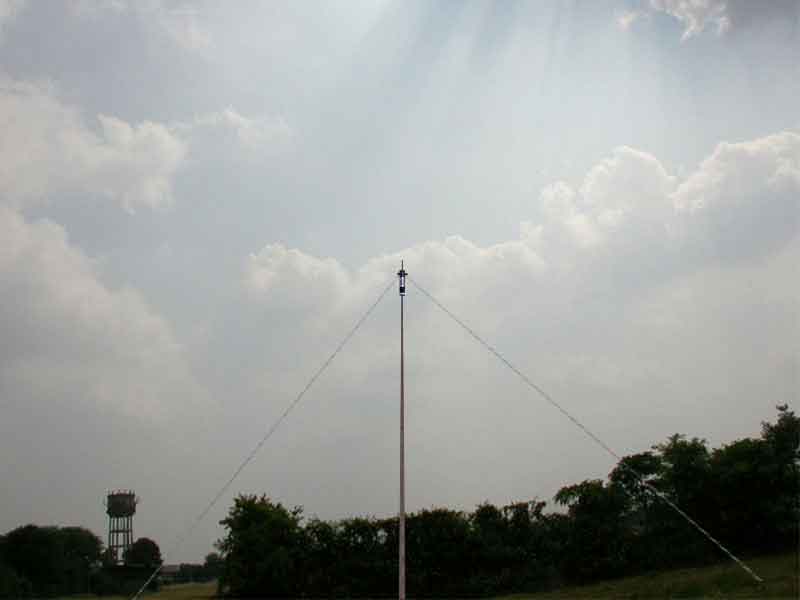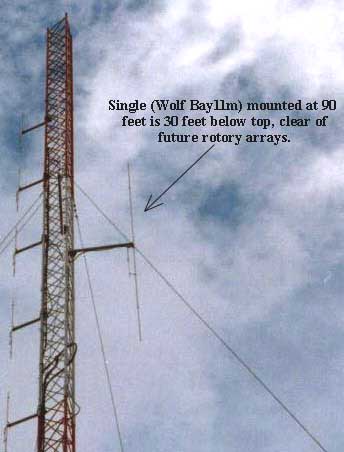
The
Dipole
PKW
 Wolf
Wolf
This antenna is the basic. It is simple to make and cost can be nearly
nothing.
Most antennas
are based on a dipole, Yagi's use a dipole antenna as the radiating
element, vertical half wave antennas are "end-fed" dipole
antenna.
And so can mobile antennas be brought back to this principle.
A dipole antenna : developed by Heindrich Rudolph Hertz around 1886 is an antenna with a center-fed driven element for transmitting or receiving radio frequency energy. These antennas are the simplest practical antennas from a theoretical point of view. ref: wikipedia
The antenna
consist out of one electrical guiding wire with a length corresponding
to the frequencies.
Often this wire is made out of copper, but any electrical guiding material
will be ok.
The 50 ohm feed point is in the middle of the antenna.
At that point the wire is separated and connected to a coax cable.
At the ends of the dipole there are insulators to make sure the antenna
The Dipole
can be found in many different shapes, it maybe erected horizontal (it
is called then a Horizontal dipole)
(as in the second picture above.)
Or could be erected vertical (iow Vertical Dipole), as in the third picture above.
Another
common shape is in an up side down V shape (it is called then in Inverted
V antenna)
as in the first picture above.
Finally you could find it in an angle of 45 degrees (called a sloping dipole).
With the variation of each shape the patterns of the antenna changes and there for personal preferences may vary.
WHICH
LENGTH ?
The first symbol is lambda, it is the sign for wavelengths.
The formula then is 299,8 divided by the F which is frequency in Mhz
) will give us the wavelength of the frequency.
Example: channel 52 (27,555) 299,8 / 27,555 = 10,88 meters
This is approximately 11 meter (that's why everybody speaks about the
11 meter band.)
WHAT
DO WE NEED ?
A dipole is a halve wave antenna, the length of the dipole for 26,285mhz
(my design frequency) would there for be : 5,70M.
So we need :
2 pieces of 2,85 m copper wire.
Two end insulators and one center piece.
Coax cable to connect the antenna to the transceiver.
center
piece -------------------------- Electrical
guiding material -------------------------------
Rope
The "professional" insulators can be bought on any ham market
or ebay etc.,
you could get the through me (cost 15 euro together. mail 19SD348@planet.nl
).
But, u do not really need them.
You can make it from wood or plastic see the chapter "SKYPPER"
for another idea.
A search on google might give u a hand a swell.
MAKING
THE ANTENNA WORK !
All you need to do is connect the individual wires (2,85m) to the center
insulator, and connect the end insulators to the other end of the wire.
Connect the coax cable to the center insulator.
Then connect the rope to the other side of the end-insulators and pull
the antenna in the air.
Now you need to check the SWR with your SWR meter.
Keep in mind that SWR varies due to - height
- ground capabilities
- nearby structures
Make always sure u make the antenna a little longer then designed. .
When the SWR is the best, lower in frequency your antenna is too long.
when the SWR is the best, higher in frequency your antenna is too short.
Start extending/cutting the length on EACH side !
On the
eznec file u can see that the gain is 0,0 dB.
This is correct a dipole doesn't have any gain compared to a dipole.
This antenna is a reference antenna to others when gain is expressed
in dBD !.
SWR MEASUREMENTS:
Below u can see how the MINIVNA antenna analyzer responded to the antenna:
The best resonant frequency was : 26,270 mhz
The Bandwidth ( 2:1 points) of the antenna is: about 1,5 mhz !
Results:
On 02 October 2008 (sunspot minimum) stations from Italy,Spain,Balearic
island,Sardinia,Cyprus, Macedonia, Bulgaria,
Corsica, Ireland were worked in a morning with only 15 watts, on 27mhz.
Now that is loads of fun with only a little money spent !